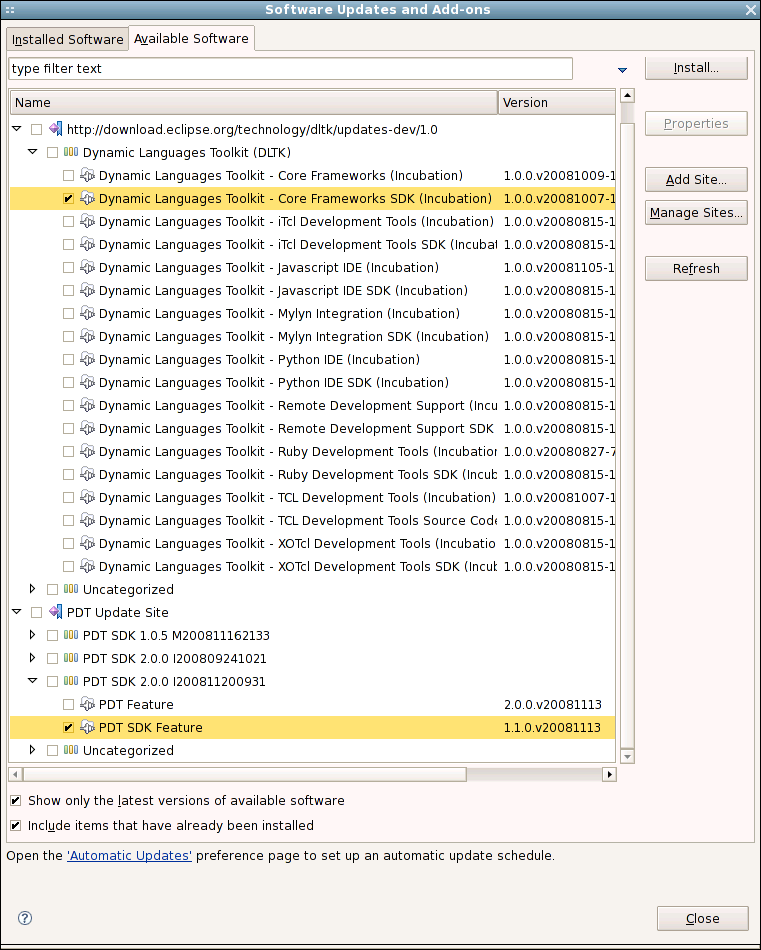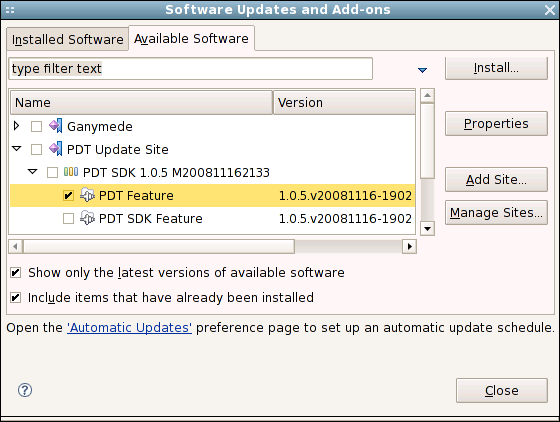Notice: this Wiki will be going read only early in 2024 and edits will no longer be possible. Please see: https://gitlab.eclipse.org/eclipsefdn/helpdesk/-/wikis/Wiki-shutdown-plan for the plan.
Difference between revisions of "PDT/Installation"
m (→Eclipse 3.4 / Ganymede / PDT 2.0) |
(→From All-In-One Package) |
||
| Line 11: | Line 11: | ||
=== From All-In-One Package === | === From All-In-One Package === | ||
| − | + | 1. [[#Install a JVM | Install a JDK or JRE]] -- the minimum required version is 5.0. | |
| − | + | 2. Go to the [http://www.eclipse.org/pdt/downloads/ PDT download page] | |
| − | + | ||
| − | + | ||
| − | + | 3. Download the latest All-In-One package that is compatible with your OS. | |
| + | :* This archive file includes the Eclipse environment, PDT and all the required dependencies you need to start developing using PDT. | ||
| − | + | 4. Unpack the archive file you've downloaded into the directory in which you want to install PDT. | |
| + | 5. Run the Eclipse executable file. | ||
=== From Update Site === | === From Update Site === | ||
Revision as of 11:07, 29 December 2008
Installing PDT is relatively easy.instructions page? Click here.
Contents
Install a JVM
Regardless of your operating system, you will need to install a Java virtual machine.
- If using Windows, you may already have one installed, but upgrading won't hurt.
- If using Linux, read this -- GCJ will NOT work.
Consider an IBM JDK or a Sun JDK. See below for minimum requirements. Note that if you are on a 64-bit platform and are using a 64-bit JRE, you need to use a 64-bit Eclipse build.
Eclipse 3.4 / Ganymede / PDT 2.0
From All-In-One Package
1. Install a JDK or JRE -- the minimum required version is 5.0.
2. Go to the PDT download page
3. Download the latest All-In-One package that is compatible with your OS.
- This archive file includes the Eclipse environment, PDT and all the required dependencies you need to start developing using PDT.
4. Unpack the archive file you've downloaded into the directory in which you want to install PDT.
5. Run the Eclipse executable file.
From Update Site
- Install a JDK or JRE -- minimum required level is 5.0.
- Get Eclipse:
- Download the latest Ganymede JEE Bundle, then unpack it and start it up.
- Start the Install Manager. You will require three update sites to perform an install of PDT 2.0.
Help > Software Updates... > Available Software > Manage Sites... Add... > add the DLTK 1.0 interim site: download.eclipse.org/technology/dltk/updates-dev/1.0/ Add... > add the PDT 2.0 interim site: download.eclipse.org/tools/pdt/updates/2.0/interim/ Enable the Ganymede Update site (if not already enabled): download.eclipse.org/releases/ganymede/ Expand the DLTK site and select the Dynamic Languages Toolkit - Core Frameworks or Dynamic Languages Toolkit - Core Frameworks SDK Feature Select the PDT or PDT SDK Feature Install... |
- Install. Restart. Enjoy.
From Zips
- Install a JDK or JRE -- minimum required level is 5.0.
- Download the latest PDT 2.0 build + all its listed dependencies, including Eclipse.
- Unpack Eclipse, then unpack everything else into your eclipse/dropins/ folder.
- Start Eclipse.
Helpful Links
Eclipse 3.4 / Ganymede / PDT 1.0.5+
NOTE: PDT 1.0.5+ requires Eclipse 3.4. For PDT with Eclipse 3.3, use PDT 1.0.3.
- Install a JDK or JRE -- minimum required level is 5.0.
- Get Eclipse:
- Download the latest Ganymede JEE Bundle, then unpack it and start it up.
- Start the Install Manager. You will require two update sites to perform an install of PDT 1.0.5+.
Help > Software Updates... > Available Software > Manage Sites... Add... > add the PDT 1.0.5+ interim site: download.eclipse.org/tools/pdt/updates/interim/ Enable the Ganymede Update site (if not already enabled): download.eclipse.org/releases/ganymede/ Select the PDT or PDT SDK Feature Install... |
- Install. Restart. Enjoy.
Eclipse 3.3 / Europa / PDT 1.0.3
- Install a JDK or JRE -- minimum required level is 5.0.
- Get Eclipse:
- If one exists for your platform (operating system, windowing system, architecture), the simplest way to install PDT is via an All-In-One bundle.
- If installing on Linux, you can look for a package from your distro maintainter/repositories, but this is not supported by eclipse.org. If you encounter problems with such a bundle, please contact your distro maintainer.
- Otherwise, download an Eclipse SDK or Runtime Binary or the Europa JEE Bundle, then unpack it.
- Start Update Manager.
Help > Software Updates > Find and Install... > (*) Search for new features > Next > [x] Europa Discovery Site > New Remote Site > add the new site: http://download.eclipse.org/tools/pdt/updates/ > Finish |
- Expand the Europa Discovery site to resolve dependencies. Collapsed sites will not be searched.
- Select the PDT feature(s) you want to install.
- Click the Select Required button to resolve missing dependencies.
- Install*. Restart. Enjoy.
Eclipse 3.2 / Callisto / PDT 0.7
- Install a JDK or JRE -- minimum required level is 1.4.2.
- Get Eclipse:
- If installing on Linux, you can look for a package from your distro maintainter/repositories, but this is not supported by eclipse.org. If you encounter problems with such a bundle, please contact your distro maintainer.
- Otherwise, download an Eclipse SDK or Runtime Binary, then unpack it and start it up.
- Start Update Manager.
Help > Software Updates > Find and Install... > (*) Search for new features > Next > New Remote Site > add the new site: http://download.eclipse.org/callisto/releases/ > New Remote Site > add the new site: http://download.eclipse.org/tools/pdt/updates/ > Finish |
- Select the projects &/or components you want to install.
- Expand the Callisto Updates site to resolve dependencies. Collapsed sites will not be searched.
- Select the PDT feature(s) you want to install.
- Click the Select Required button to resolve missing dependencies.
- If it does not work, you will have to manually select dependencies.
- Install*. Restart. Enjoy.
Debugger
The PDT project does not contain server side implementation for PHP debugging and will welcome any open source or commercial implementation of the debug protocol.
PHP Executable Debugger
- Zend Executable Debugger - A free Eclipse plugin that adds PHP executable debug capabilities to the Eclipse environment.
PHP Web Server Debugger
- Zend Web Server Debugger - Web server debugger binaries which should be installed on the web server.
- XDebug Components - XDebug component for web server debugging.
Known Problems
- If after installing PDT you do not see the PDT perspective, views/editors/file associations do not work, or your get "An error occurred" messages, try restarting Eclipse with the -clean flag.
- You may find that your chosen mirror fails due to bug 203794. Until that bug is fixed, try another mirror, or try an FTP site instead of an HTTP site.
- You may encounter problems on linux with non-existant cups servers in
/etc/cups/client.conf(bug 242677). Try running with./eclipse -Dorg.eclipse.swt.internal.gtk.disablePrinting.
- You may encounter this error message: Problem occurred: 'Selection Job titile' has encountered a problem. If so, you need to install DLTK 1.0.I200807181303 (or newer). Unpack the zip into your dropins folder (see From Zips above). See also bug 242947.
- Another variation reported to work: PDT 2.0.0 N20080823 + DLTK Core 0.95.0.v20080716 + DLTK RDS 0.95.0.v20080623
- If updating from a nightly build to a newer nightly, you will need to uninstall and then reinstall PDT. See bug 241341.


